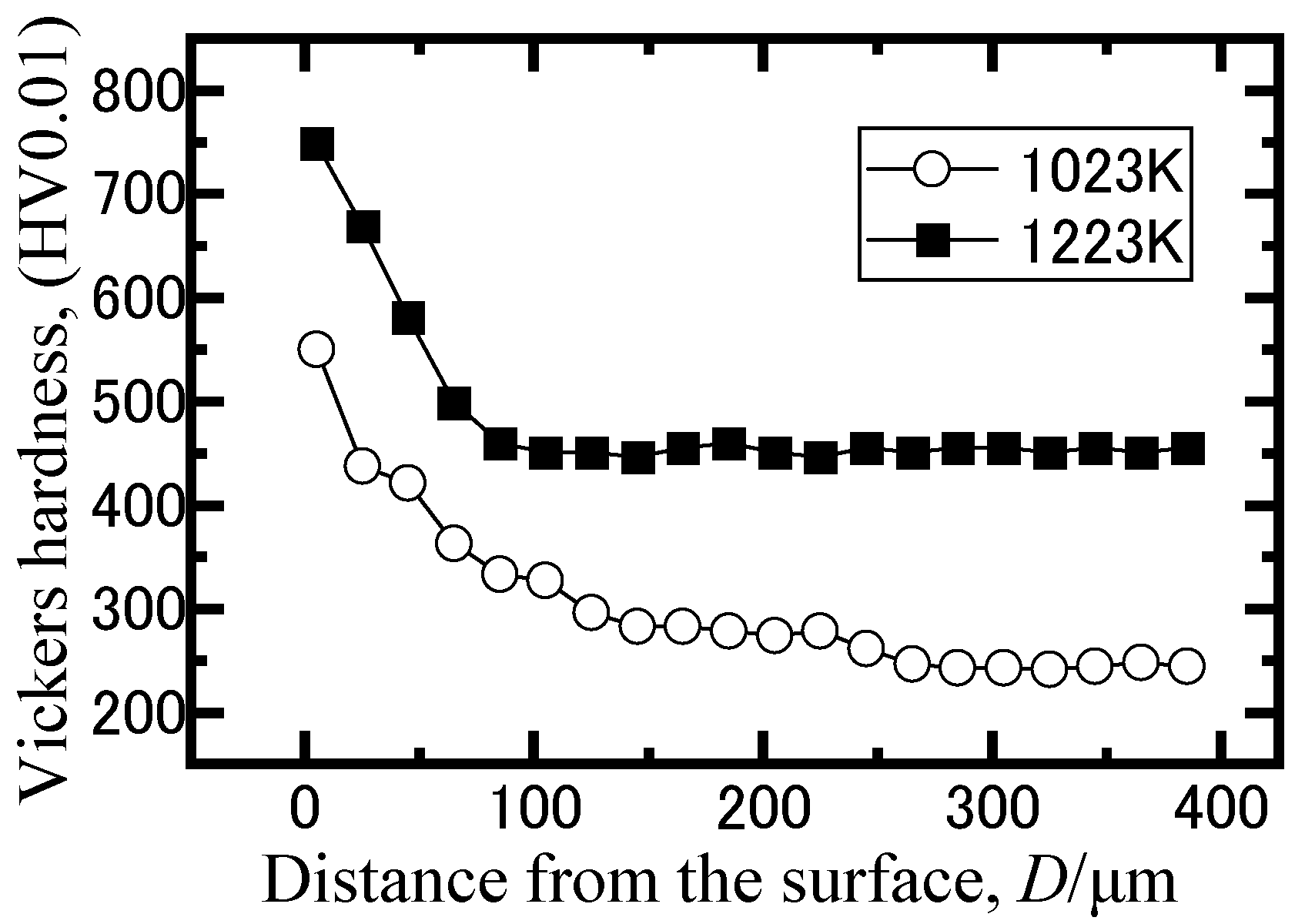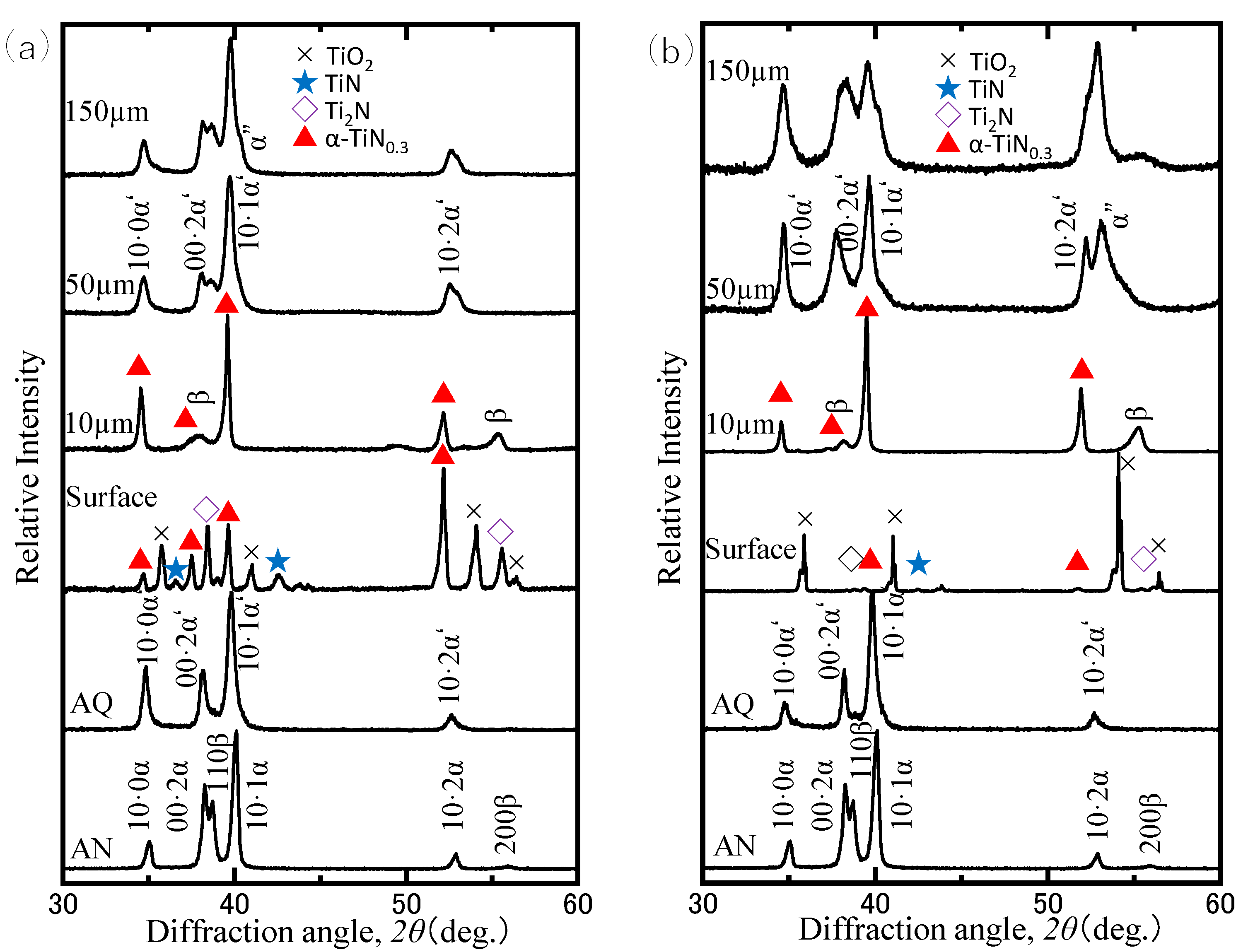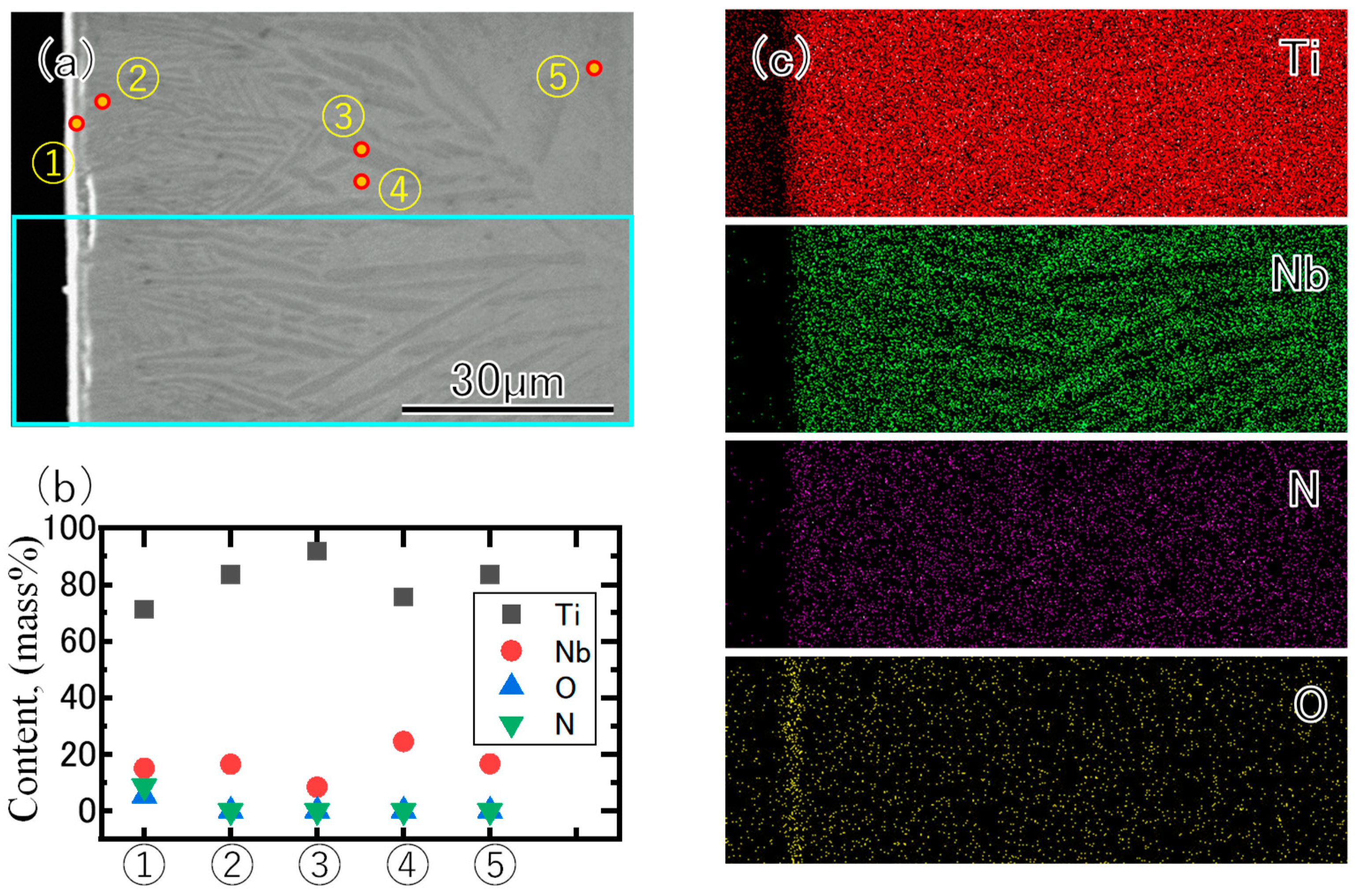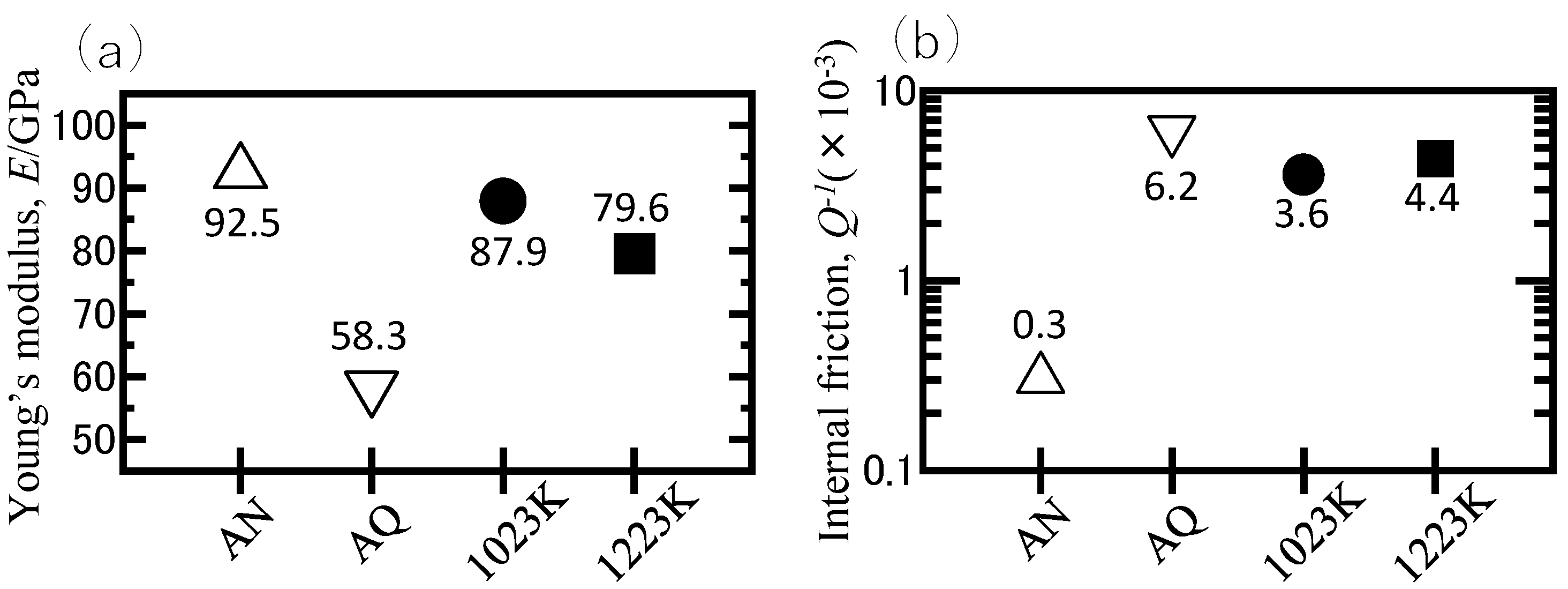Microstructure and Material Properties of Ti-15mass%Nb Alloy after Gas Nitriding and Quenching Process
Abstract
:1. Introduction
2. Materials and Methods
3. Results
4. Discussion
5. Conclusions
- (1)
- As a result of changing the hardness in the depth direction after GNQP, the region of α-TiN0.3 and β phase was formed at approximately 80 µm at 1023 and 1223 K, and this region was hardened. It was established that the hardness of the α′ martensite was observed in the region deeper than 250 µm at 1023 K, whereas the inside was also very hard at 1223 K. From the XRD result at 1223 K, it was established that although the martensite structure was formed in the internal region, it was extremely strained.
- (2)
- It was established that the Q−1 of the specimens after GNQP was relatively high, though both 1023 and 1223 K did not reach the AQ specimen due to the influence of the surface structure. In addition, the E showed a high value close to that of the AN specimen. From these results, it is considered that the material property values of the alloy can be controlled by the GNQP heat treatment.
Author Contributions
Funding
Conflicts of Interest
References
- Ozaki, T.; Matsumoto, H.; Watanabe, S.; Hanada, S. Beta Ti alloys with low young’s modulus. Mater. Trans. 2004, 45, 2776–2779. [Google Scholar] [CrossRef] [Green Version]
- Matsumoto, H.; Watanabe, S.; Hanada, S. α′ martensite Ti-V-Sn alloys with low Young’s modulus and high strength. Mater. Sci. Eng. A 2007, 448, 39–48. [Google Scholar] [CrossRef]
- Bönish, M.; Calin, M.; Humbeeck, J.V.; Skrotzki, W.; Eckert, J. Factors influencing the elastic moduli, reversible strains and hysteresis loops in martensitic Ti-Nb alloys. Mater. Sci. Eng. C 2015, 48, 511–520. [Google Scholar] [CrossRef]
- Kim, H.Y.; Hashimoto, S.; Kim, J.I.; Hosoda, H.; Miyazaki, S. Mechanical Properties and Shape Memory Behavior of Ti-Nb Alloys. Mater. Trans. 2004, 45, 2443–2448. [Google Scholar] [CrossRef] [Green Version]
- Kim, J.I.; Kim, H.Y.; Hosoda, H.; Miyazaki, S. Shape Memory Behavior of Ti-22Nb-(0.5–2.0)O(at%) Biomedical Alloys. Mater. Trans. 2005, 46, 852–857. [Google Scholar] [CrossRef] [Green Version]
- Kim, H.Y.; Ikehara, Y.; Kim, J.I.; Hosoda, H.; Miyazaki, S. Martensitic transformation, shape memory effect and superelasticity of Ti–Nb binary alloys. Acta Mater. 2006, 54, 2419–2429. [Google Scholar] [CrossRef]
- Inamura, T.; Fukui, Y.; Hosoda, H.; Wakashima, K.; Miyazaki, S. Relationship between texture and macroscopic transdormation strain in severely colled-rolled Ti-Nb-Al superelastic alloy. Mater. Trans. 2004, 45, 1083–1089. [Google Scholar]
- Niinomi, M.; Akahori, T.; Nakai, M. In situ X-ray analysis of mechanism of nonlinear super elastic behavior of Ti-Nb-Ta-Zr system beta-type titanium alloy for biomedical applications. Mater. Sci. Eng. C 2008, 28, 406–413. [Google Scholar] [CrossRef]
- Kuramoto, S.; Nishino, K.; Saitou, S. Multifunctional titanium alloy. J. JILM 2005, 55, 618–623. [Google Scholar] [CrossRef]
- Mantani, Y.; Tsumura, T.; Nakata, K. Effect of α’ martensite structure of Ti-15Nb alloy on material properties and its surface hardening treatment by plasma nitriding. J. Jpn. Soc. Heat Treat. 2012, 52, 263–268. [Google Scholar]
- Mantani, Y.; Kudou, K. Effect of plastic deformation on material properties in martensite structures of Ti-Nb alloys. J. Alloys Comp. 2013, 577S, S448–S452. [Google Scholar] [CrossRef]
- Mantani, Y.; Takemoto, Y. Change in crystal structure and material properties with deformation of quenched martensite in Ti-Nb alloys. J. Jpn. Inst. Met. Mater. 2015, 79, 461–467. [Google Scholar] [CrossRef] [Green Version]
- Rolinski, E. Mechanism of high-temperature plasma nitriding of titanium. Mater. Sci. Eng. 1988, 100, 193–199. [Google Scholar] [CrossRef]
- Rolinski, E. Surface properties of plasma-nitrided titanium alloys. Mater. Sci. Eng. 1989, A108, 37–44. [Google Scholar] [CrossRef]
- Bacci, T.; Pradelli, G.; Tesi, B.; Gianoglio, C.; Badini, C. Surface engineering and chemical characterization in ion-nitrided titanium and titanium alloys. J. Mater. Sci. 1990, 25, 4309–4314. [Google Scholar] [CrossRef]
- Sato, T.; Akashi, K. Surface modification of Ti-6Al-4V alloy by plasma nitriding. J. JILM 1992, 42, 650–656. [Google Scholar] [CrossRef] [Green Version]
- Da Silva, S.L.R.; Kerber, L.O.; Amaral, L.; Da Santos, C.A. X-ray diffraction measurements of plasma-nitrided Ti-6Al-4V. Surf. Coat. Technol. 1999, 116–119, 342–346. [Google Scholar] [CrossRef]
- Kapczinski, M.P.; Kinast, E.J.; Da Dos Santos, C.A. New-surface composition and tribological behavior of plasma nitride titanium. J. Phys. D Appl. Phys. 2003, 36, 1858–1863. [Google Scholar] [CrossRef] [Green Version]
- Zhecheva, A.; Sha, W.; Malinov, S.; Long, A. Enhancing the microstructure and properties of titanium alloys through nitriding and other surface engineering methods. Surf. Coat. Technol. 2005, 200, 2192–2207. [Google Scholar] [CrossRef]
- Ge, L.; Tian, N.; Lu, Z.; You, C. Influence of surface nanocrystallization on the gas nitriding of Ti-6Al-4V alloy. Appl. Surf. Sci. 2013, 286, 412–416. [Google Scholar] [CrossRef]
- Miyagi, M.; Sato, Y.; Mizuno, T.; Sawada, S. ESCA study on nitriding of titanium. J. Jpn. Inst. Metals 1979, 43, 939–947. [Google Scholar] [CrossRef] [Green Version]
- Yan, X.; Kato, M.; Nakasa, K.; Morita, K. Evaluation of fracture strength and interfacial strength of titanium-nitride layers formed by gas nitriding of titanium. J. Soc. Mat. Sci. Jpn. 2001, 50, 764–771. [Google Scholar] [CrossRef]
- Nakai, M.; Niinomi, M.; Akahori, T.; Ohtsu, N.; Ogawa, M.; Nishimura, H.; Toda, H.; Fukui, H.; Ogawa, M. Surface hardening of biomedical Ti-29Nb-13Ta-4.6Zr and Ti-6Al-4V ELI by gas nitriding. Mater. Sci. Eng. A 2008, 486, 193–201. [Google Scholar] [CrossRef]
- Haibin Li, H.; Cui, Z.; Li, Z.; Zhu, S.; Yang, X. Effect of gas nitriding treatment on cavitation behavior of commercially pure Ti and Ti-6Al-4V alloy. Surf. Coat. Technol. 2013, 221, 29–36. [Google Scholar]
- Li, H.; Cui, Z.; Li, Z.; Zhu, S.; Yang, X. Surface modification by gas nitriding for improving cavitation erosion resistance of CP-Ti. Appl. Surf. Sci. 2014, 298, 164–170. [Google Scholar] [CrossRef]
- Liu, J.; Suslov, S.; Vellore, A.; Ren, Z.; Amanov, A.; Pyun, Y.S.; Martini, A.; Dong, Y.; Ye, C. Surface nonocystallization by ultrasonic nano-crystal surface modification and its effect on gas nitriding of Ti6Al4V alloy. Mater. Sci. Eng. A 2018, 736, 335–343. [Google Scholar] [CrossRef]
- Yang, C.; Liu, J. Intermittent vacuum gas nitriding of TB8 titanium alloy. Vacuum 2019, 163, 52–58. [Google Scholar] [CrossRef]






Publisher’s Note: MDPI stays neutral with regard to jurisdictional claims in published maps and institutional affiliations. |
© 2020 by the authors. Licensee MDPI, Basel, Switzerland. This article is an open access article distributed under the terms and conditions of the Creative Commons Attribution (CC BY) license (http://creativecommons.org/licenses/by/4.0/).
Share and Cite
Mantani, Y.; Shimada, K.; Eguchi, N. Microstructure and Material Properties of Ti-15mass%Nb Alloy after Gas Nitriding and Quenching Process. Crystals 2020, 10, 1156. https://doi.org/10.3390/cryst10121156
Mantani Y, Shimada K, Eguchi N. Microstructure and Material Properties of Ti-15mass%Nb Alloy after Gas Nitriding and Quenching Process. Crystals. 2020; 10(12):1156. https://doi.org/10.3390/cryst10121156
Chicago/Turabian StyleMantani, Yoshikazu, Kentaro Shimada, and Naoki Eguchi. 2020. "Microstructure and Material Properties of Ti-15mass%Nb Alloy after Gas Nitriding and Quenching Process" Crystals 10, no. 12: 1156. https://doi.org/10.3390/cryst10121156



